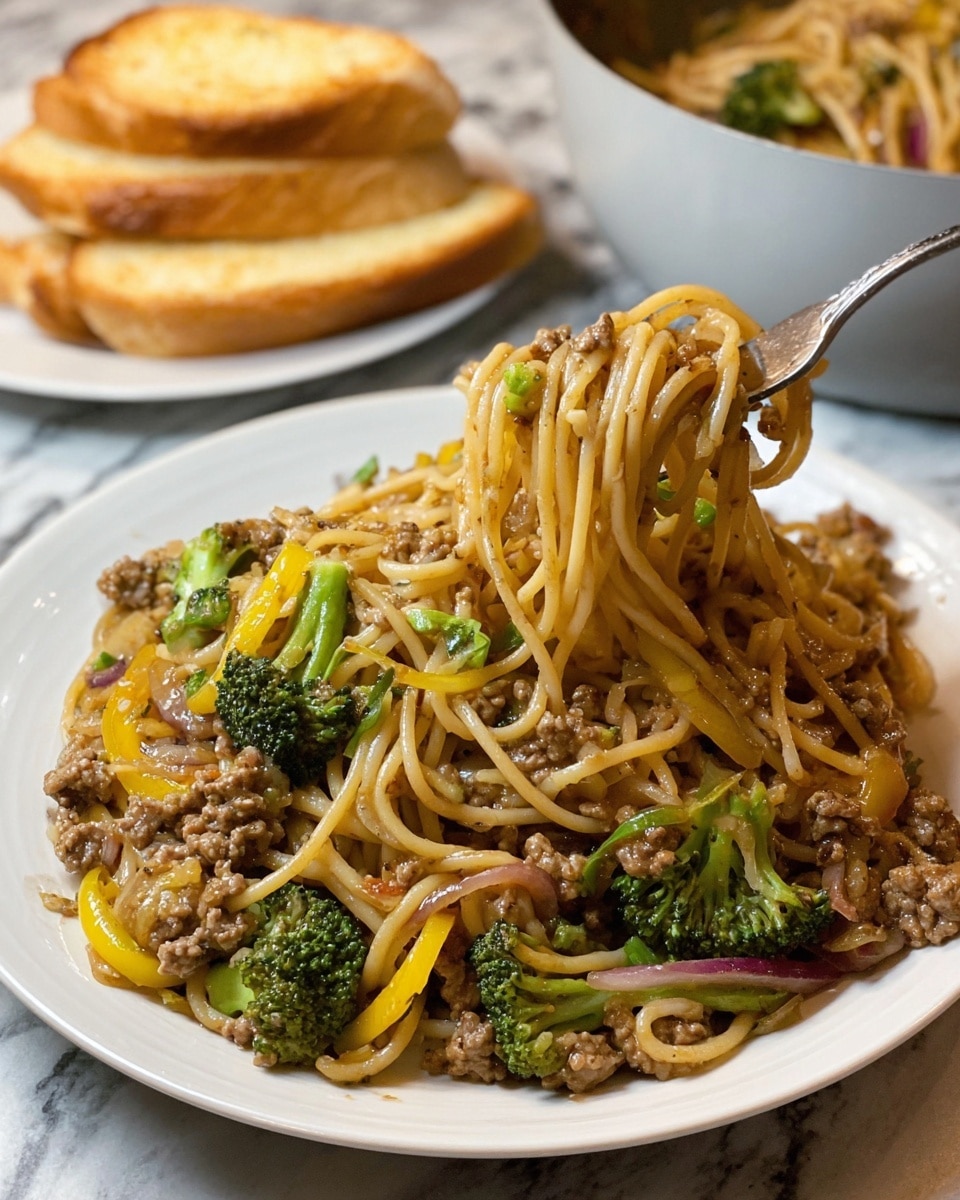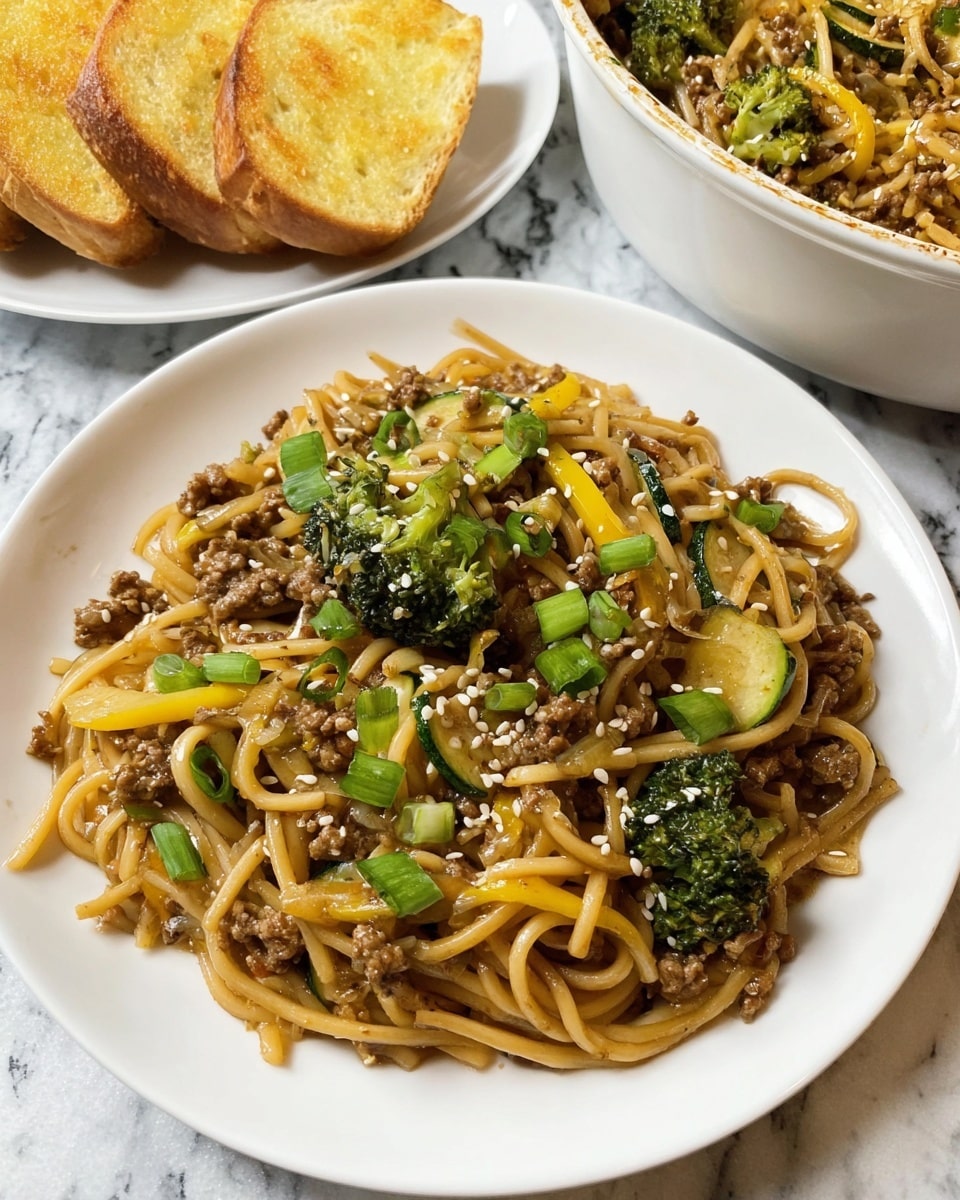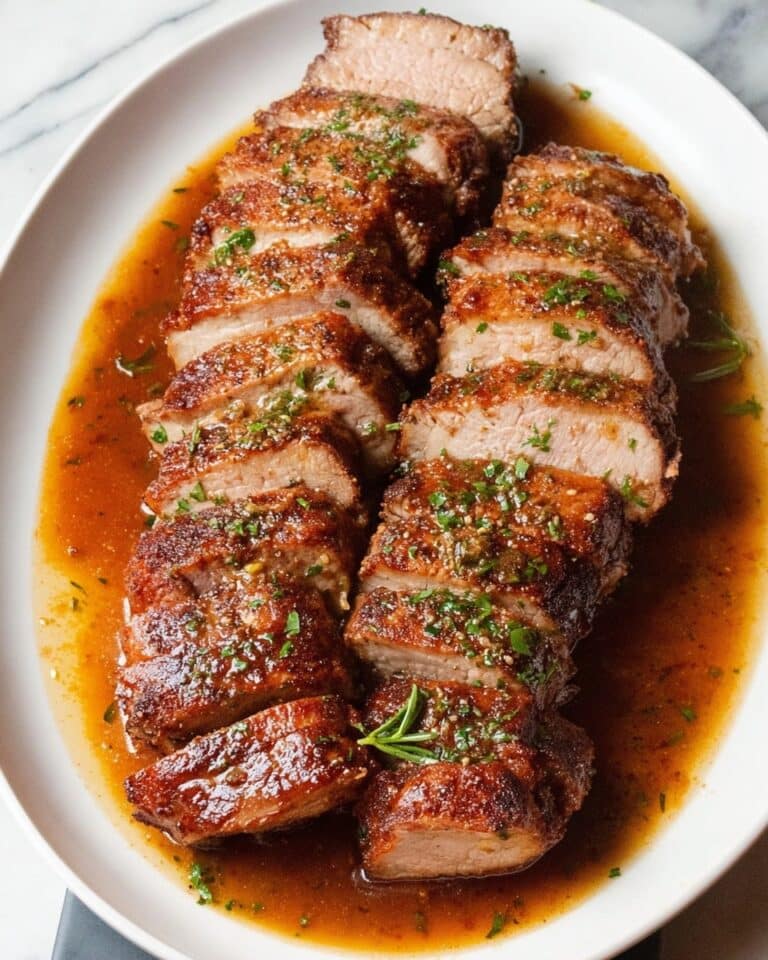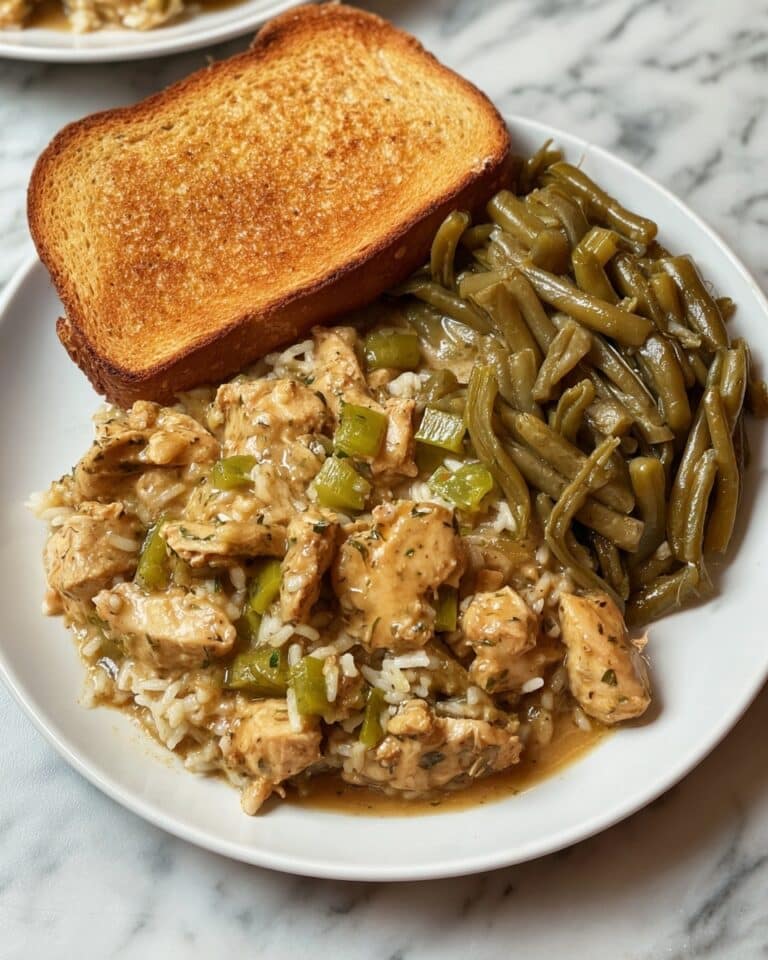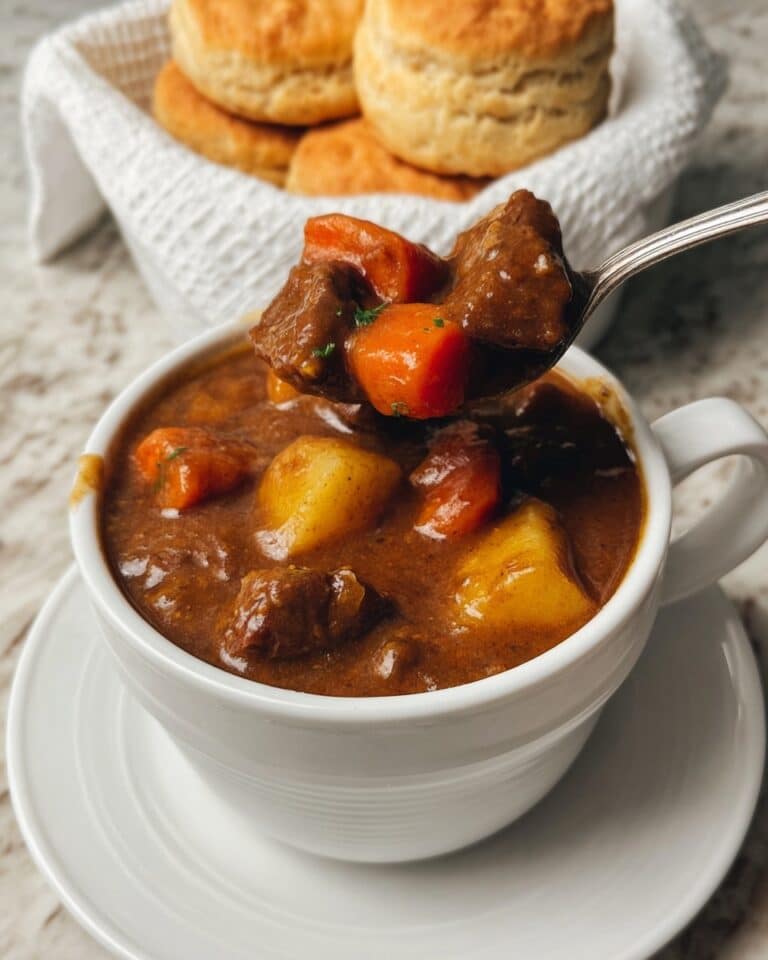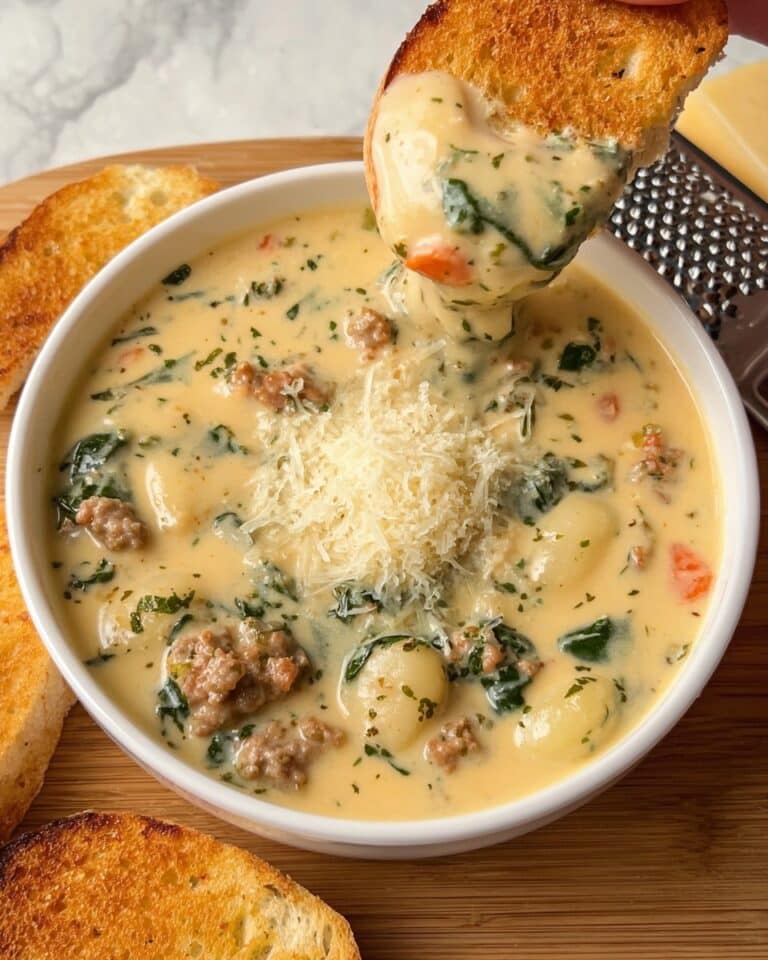Mongolian Ground Beef and Noodles with Vegetables Recipe
Oh, I can’t wait to share this Mongolian Ground Beef and Noodles with Vegetables Recipe with you! This dish combines all the best parts: hearty ground beef, tender noodles, and vibrant veggies tossed in a sweet-savory sauce that just makes your taste buds dance. It’s a weeknight winner that feels special enough for company, yet quick enough for those busy evenings when cooking seems like a chore.
What I love most about this Mongolian Ground Beef and Noodles with Vegetables Recipe is how it’s such a versatile, crowd-pleasing meal. Whether you’re cooking for family, meal prepping for the week, or craving something comforting with a little Asian-inspired flair, this recipe hits the spot every time. Plus, the way those noodles soak up the sauce — it’s pure magic.
Why This Recipe Works
- Balanced Flavors: The sweet soy and brown sugar combo perfectly complements the umami of the ground beef.
- Textural Variety: Crisp-tender vegetables, tender noodles, and juicy beef create a satisfying mouthfeel.
- Quick & Flexible: It comes together in under 30 minutes and works great with different veggies or pasta types.
- Family-Friendly: Mild but flavorful, you can easily adjust heat and ingredients to please all palates.
Ingredients & Why They Work
Let’s talk about the ingredients that make this Mongolian Ground Beef and Noodles with Vegetables Recipe come alive. Each component plays its part—fresh veggies add crunch and brightness, while the sauce brings that signature Mongolian flavor punch. I always recommend picking fresh, colorful produce to keep this dish vibrant.
- Red Onion: Adds a mild sweetness and depth; slicing it thin helps it cook quickly and blend into the sauce.
- Zucchini: Offers a tender texture and mild flavor that soaks up the sauce beautifully without overpowering.
- Broccoli Florets: Their slight bitterness balances the sweet sauce and adds a nice crunch that holds up well in stir-frying.
- Bell Pepper: Brings pop of color and sweetness; you can use any color you like—red, yellow, or orange all shine.
- Ground Beef: A hearty protein base that browns nicely and carries all the sauces and seasonings with ease.
- Garlic: Essential for that punch of aromatic flavor; I never skimp on garlic here.
- Spaghetti (or other long pasta): While not traditional, these noodles work beautifully as a base, soaking up sauce and melding everything together.
- Soy Sauce: Provides salty, umami depth; I recommend low-sodium if you want to control the saltiness.
- Brown Sugar: Gives balance and sweetness that elevates the savory components.
- Hoisin Sauce: Brings complexity with sweet, tangy, and slightly spicy notes, rounding out the sauce perfectly.
- Ginger Paste: Adds zing and warmth; fresh ginger or paste both work, but fresh always feels brighter.
- Black Pepper: For subtle heat and earthiness.
- Red Chili Crisp or Red Pepper Flakes: Optional but highly recommended if you love a little spicy kick.
- Cornstarch: Thickens the sauce so it clings lovingly to the noodles and beef.
- Green Onions and Sesame Seeds (Garnishes): Finish the dish with fresh, mild sharpness and nutty crunch for an extra layer of texture and flavor.
- Olive Oil: For sautéing veggies and browning beef; I love using a neutral oil with a high smoke point but olive oil works wonderfully here.
Make It Your Way
I love making this Mongolian Ground Beef and Noodles with Vegetables Recipe my own, and I encourage you to do the same! Whether you want to swap the veggies, go leaner on the beef, or dial up the spice, there’s plenty of room to customize without losing that signature Mongolian vibe.
- Vegetable Variations: I’ve tried adding snap peas or shredded carrots when I want extra crunch, and it’s just as delicious.
- Protein Swaps: Once I swapped ground turkey instead of beef for a lighter twist — still tasty but leaner!
- Spice Levels: Feel free to adjust the chili crisp or add fresh sliced chilies if you like it hotter; I prefer just a little heat for balance.
- Gluten-Free: Use rice noodles or gluten-free pasta instead of spaghetti if you need to avoid gluten—just watch the cooking times.
Step-by-Step: How I Make Mongolian Ground Beef and Noodles with Vegetables Recipe
Step 1: Sauté Your Veggies to Tender-Crisp Perfection
Start by heating olive oil in a large skillet over medium heat and toss in those vibrant veggies—sliced red onion, zucchini half moons, broccoli florets, and bell pepper strips. Season with a pinch of salt and pepper and sauté for about 5 minutes. You’re looking for the veggies to be tender but still with a slight crunch; this keeps the texture lively in the final dish. Once done, scoop them out and set aside — don’t overcook here, trust me, it pays off!
Step 2: Cook the Noodles Just Right
Time to cook the spaghetti (or your choice of noodle). Boil it in salted water according to package instructions until al dente. Here’s a pro tip: save about ½ to 1 cup of that starchy pasta water before draining—that magic liquid will help your sauce cling perfectly to the noodles later on.
Step 3: Whisk Together the Flavor-Packed Sauce
In a small bowl, whisk the soy sauce, brown sugar, hoisin sauce, ginger paste, black pepper, red chili crisp (if using), and cornstarch until smooth. This sauce blends savory, sweet, and a hint of spice all in one bowl—so good you might be tempted to just sip it!
Step 4: Brown the Ground Beef with Garlic
Using the same skillet (no need to dirty another!), brown your ground beef over medium-high heat. Add the minced garlic and cook until the beef is nicely browned and cooked through, about 5–7 minutes. Drain any excess grease to keep the dish from getting greasy—this little step keeps everything balanced and clean.
Step 5: Bring It All Together
Return the sautéed vegetables to the skillet along with your cooked pasta. Pour the sauce over, then add some of that reserved pasta water, starting with half a cup and adding more if needed to loosen and help the sauce coat everything beautifully. Toss everything gently over low heat until the sauce thickens and clings to every noodle and piece of beef—this usually takes a couple of minutes. Your kitchen is going to smell incredible!
Step 6: Garnish and Serve
Finish with a sprinkle of sliced green onions and sesame seeds for that extra pop of color, texture, and flavor. Serve it straight from the skillet while it’s piping hot—you’ll want to dig right in!
Tips from My Kitchen
- Don’t Skip the Pasta Water: The reserved starchy water is the secret to a silky sauce that binds the dish together.
- Cook Veggies Separately: It keeps their texture fresh instead of soggy, and you can control each element perfectly.
- Taste As You Go: Especially with the sauce—sometimes I add a little more soy or sugar depending on how the flavors develop.
- Avoid Overcrowding the Pan: Give your ground beef enough room to brown nicely instead of steaming — you’ll get better flavor and texture.
How to Serve Mongolian Ground Beef and Noodles with Vegetables Recipe
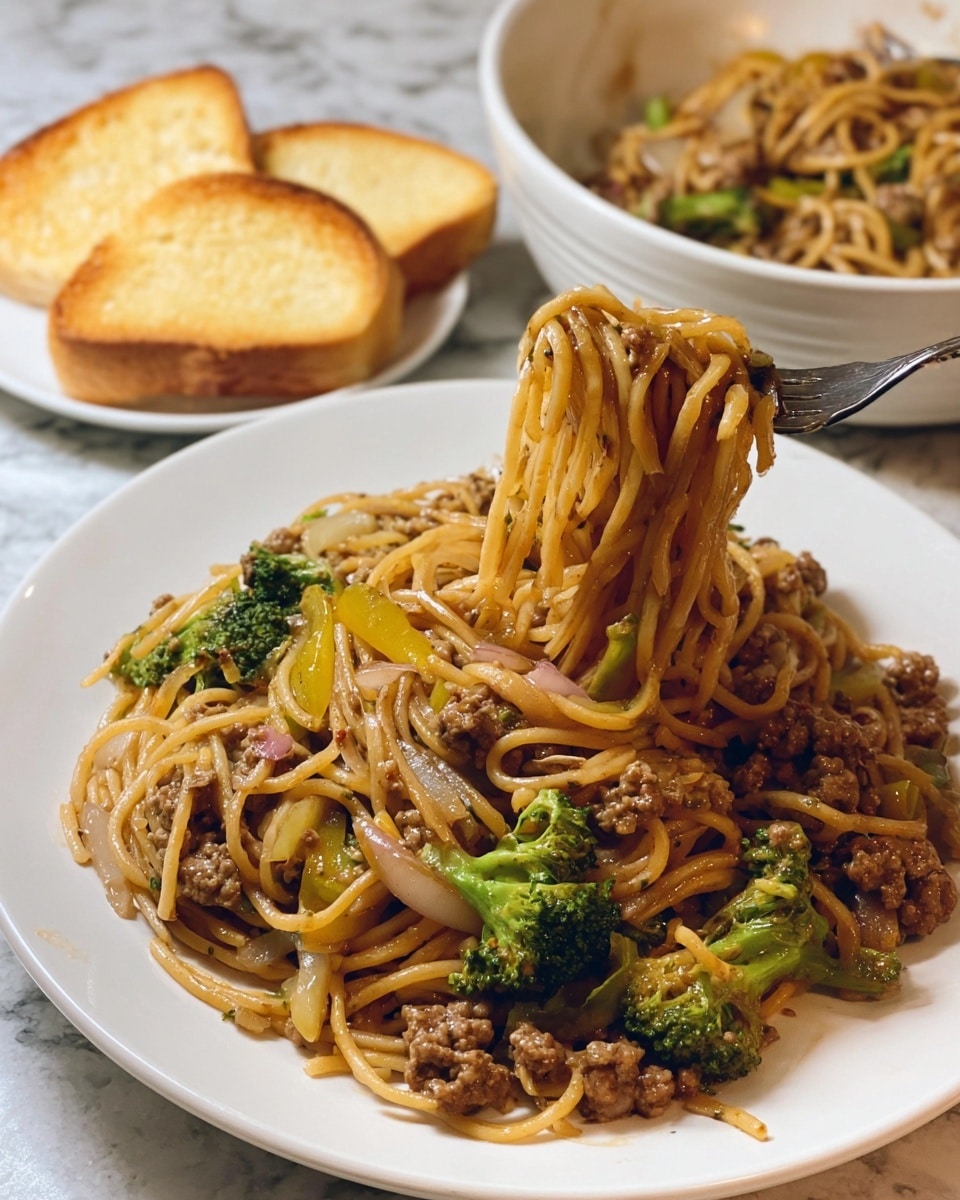
Garnishes
I usually top my Mongolian Ground Beef and Noodles with Vegetables Recipe with a handful of sliced green onions and a sprinkle of sesame seeds—they add the perfect crunch and a lovely nutty note. For a little extra zing, sometimes I drizzle a touch of chili oil or scatter finely chopped fresh cilantro.
Side Dishes
To round out the meal, I enjoy pairing this recipe with simple sides like steamed jasmine rice, a light cucumber salad, or even roasted edamame for some extra plant power. It’s such a complete dish you can even serve it solo for a satisfying dinner.
Creative Ways to Present
For special occasions, I’ve served this Mongolian Ground Beef and Noodles with Vegetables Recipe in colorful bamboo steamers or styled it on family-style platters with extra garnishes on the side to let everyone customize their bowls. It’s surprisingly festive and always gets compliments!
Make Ahead and Storage
Storing Leftovers
When I have leftovers, I store them in airtight containers in the fridge, and they stay great for up to 4 days. The flavors actually get better after a day, but the noodles might soak up a little more sauce, so I usually add a splash of soy sauce or water when reheating.
Freezing
I’ve frozen this recipe a couple of times when life got hectic. Just know the noodles and veggies can get a slightly softer texture after freezing, but it still tastes fantastic. Freeze it in portion-sized airtight containers and thaw overnight in the fridge before reheating.
Reheating
To heat leftovers, I prefer warming it gently in a skillet on medium-low, adding a splash of water or soy sauce if it looks dry. You can also microwave it covered with a damp paper towel, though stovetop reheating keeps the texture better.
FAQs
-
Can I use other types of noodles in the Mongolian Ground Beef and Noodles with Vegetables Recipe?
Absolutely! While spaghetti works well and is easy to find, you can swap in linguini, fettucine, lo mein noodles, or even rice noodles. Just be sure to adjust cooking times according to package instructions, and keep some reserved pasta water to help with the sauce.
-
What if I want to make this recipe vegetarian?
You can replace ground beef with firm tofu crumbles or a plant-based mince. Add a bit more garlic and maybe a splash of mushroom soy sauce to boost umami flavors. Don’t forget to check your hoisin and soy sauces to ensure they’re vegetarian-friendly.
-
Is this recipe spicy?
The recipe is mild by default but includes optional red chili crisp or red pepper flakes to add some heat. You can easily adjust the spice level to your liking or skip it altogether for a kid-friendly version.
-
How do I prevent the noodles from getting soggy?
Cooking your noodles just until al dente and tossing them quickly in the skillet with sauce over low heat helps keep the texture. Avoid overcooking noodles in boiling water, and don’t add too much pasta water at once.
Final Thoughts
This Mongolian Ground Beef and Noodles with Vegetables Recipe is one of those dishes I keep coming back to when I want something comforting but still bright and full of flavor. It’s approachable, adaptable, and honestly, just plain delicious. I hope you get as much joy out of making and eating it as I do—promise it’ll become one of your go-to favorites too!
Print
Mongolian Ground Beef and Noodles with Vegetables Recipe
- Prep Time: 10 minutes
- Cook Time: 20 minutes
- Total Time: 30 minutes
- Yield: 6 servings
- Category: Main Course
- Method: Stovetop
- Cuisine: Asian
Description
A flavorful Mongolian Ground Beef and Noodles dish packed with tender vegetables and a rich, savory sauce. This easy stir-fry combines ground beef, fresh vegetables, and long pasta noodles tossed in a sweet and tangy soy-hoisin sauce, perfect for a quick and satisfying weeknight meal.
Ingredients
For the Stir Fry
- 1 small sliced red onion
- 1 medium zucchini, sliced into half moons
- 1 cup broccoli florets, chopped
- 1 bell pepper, any color, sliced into strips or bite-sized chunks
- 2 tbsp olive oil
- 1 lb ground beef
- 6-7 garlic cloves, minced
- 8 oz spaghetti or any long pasta such as linguini, fettucine, or lo mein noodles
- 1/2 to 1 cup reserved pasta water
- 2 green onions, sliced, for garnish (optional)
- Sesame seeds, for garnish (optional)
For the Sauce
- 1/2 cup soy sauce
- 1/4 cup brown sugar
- 3 tbsp hoisin sauce
- 1 tbsp ginger paste
- 1 tsp black pepper
- 1 tsp red chili crisp in oil or red pepper flakes (optional for heat)
- 1 tbsp cornstarch
Instructions
- Prepare the Vegetables: Heat olive oil in a large skillet over medium heat. Add sliced red onion, zucchini, broccoli florets, and bell pepper. Season with salt and pepper to taste. Sauté the vegetables for 5 minutes until they are tender-crisp. Remove the vegetables from the skillet and set aside.
- Cook the Pasta: Boil a large pot of salted water. Cook the spaghetti or preferred noodles according to package instructions until al dente. Reserve 1/2 to 1 cup of the pasta cooking water before draining the noodles.
- Make the Sauce: In a small bowl, whisk together soy sauce, brown sugar, hoisin sauce, ginger paste, black pepper, red chili crisp or red pepper flakes (if using), and cornstarch until smooth and well combined.
- Brown the Beef: Using the same skillet, add ground beef and minced garlic. Cook over medium heat until the beef is browned and cooked through, breaking it into crumbles as it cooks. Drain any excess grease from the skillet.
- Combine Ingredients: Return the sautéed vegetables to the skillet with the browned beef. Add the cooked pasta, poured sauce, and reserved pasta water. Toss everything together over low heat to combine and allow the sauce to thicken, coating the noodles and beef evenly.
- Garnish and Serve: Remove from heat. Garnish with sliced green onions and sesame seeds if desired. Serve the Mongolian ground beef and noodles hot for a delicious and hearty meal.
Notes
- Store leftovers in an airtight container in the refrigerator for up to 4 days.
- Reheat gently in the microwave or on the stovetop with a splash of water or soy sauce to loosen the noodles.
- This dish can be frozen, but the texture of vegetables and noodles may change slightly upon thawing. Freeze in a freezer-safe container for up to 2 months and thaw overnight in the refrigerator before reheating.
- You can substitute spaghetti with any long noodles you prefer, such as lo mein or linguini.
- Adjust the heat by adding more or less chili crisp or red pepper flakes according to your taste.
Nutrition
- Serving Size: 1 serving
- Calories: 450 kcal
- Sugar: 12 g
- Sodium: 900 mg
- Fat: 18 g
- Saturated Fat: 6 g
- Unsaturated Fat: 10 g
- Trans Fat: 0 g
- Carbohydrates: 45 g
- Fiber: 5 g
- Protein: 28 g
- Cholesterol: 70 mg

